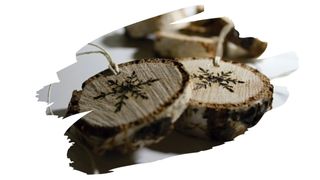Teak wood is a beautiful rich brown timber widely used for boat decking and outdoor furniture. Thanks to it’s natural rot-resistance, this hardwood is one of the most durable lumbers around.
But, when it comes to wood burning artwork, does Teak wood also make for a fantastic pyrography canvas too?
Well, in this post, we cover the four things you need to check for when it comes to pyrography wood. You’ll also learn why Teak wood has a reputation for being one of the most rot-resistant timbers on the market.
And keep reading to discover which North American hardwood is the best (and most affordable) pyrography wood.

This post may contain affiliate links to products that we receive a commission for (at no additional cost to you). Learn more here.
What’s The Best Type Of Pyrography Wood You Can Use?
Well, when it comes to pyrography, you need a timber that’s both an ideal canvas and is clean burning.
So, general rule of thumb, the best pyrography woods fit the following four criteria.
1). They Have Light Color Grain
If you want drawings to show up clearly, then you need a backdrop that contrasts starkly against burn lines.
This is very important if you plan on doing any intricate shading techniques. Particularly when darker tone wood grains can obscure the image.
2). They Have Straight Uniform Grain
Wood types with very stark contrasting grain, (such as Red Oak), can effect the overall clarity of your artwork.
Related Post: Beginners Guide To Reducing Oak Grain Contrast (Explained)
3). They’re Not Saturated With Tree Sap/Pitch Or Oils
If that wood is saturated with resins and/or oils, it will be difficult for you to burn clean lines. That’s because as your pyrography pen heats up those resins, they bubble and boil over.
So, sap-saturated wood types, such as Cedar and Pine, are tricky to draw on. Also, any wood that’s already had finish or stain applied to it, is going to be troublesome to burn.
4). They Do Not Contain Toxins, Chemicals, Or Poisonous Compounds
There are some trees that are much too poisonous to burn — even with a pyrography pen.
Related Post: Can You Safely Burn Camphor Wood In A Fireplace?
On top of that, certain types of manufactured woods, such as Plywood, contain formaldehyde-based adhesives. So, burning these engineered woods pose a risk to your health that simply isn’t worth taking.
Got It. So, What Is The Best Wood Choice For Pyrography?
Basswood is easily one of the best options for pyrography. Not only does this North American hardwood more than meet all four criteria for pyrography wood, it’s also very affordable.
If you want to learn more about why Basswood is such a great choice for your next wood burning artwork, check out our posts here: Is Basswood A Good Wood For Pyrography?
That’s All Well And Good, But What about Teak? Can You Wood Burn On Teak Wood Too?
You could…but you better be prepared for a world of disappointment.
You see, Teak wood is a very rot-resistant hardwood. And this is in no small part due to the natural oils saturating this tropical hardwood.
This oil isn’t like the tree sap resin you’d find in Pine. Instead, the natural oils inside Teak wood are much thicker.
Now, on one hand, this makes Teak wood great for making outdoor decking, since it is so water-resistant. But, all of that extra tree oil makes Teak as difficult to work with as any sap-saturated wood.
So, this oily lumber is frustrating to burn into. Especially if you’re working on an image that has a lot of shading.
What About As A Practice Wood? Can You Use Teak Wood For That?
Well, there are two reasons why you don’t really want to use Teak for practicing on either;
1). It Has Dark Grain
Teak wood is a rich brown lumber that, (once it comes into contact with sunlight), can begin to oxidize. And when this happens, Teak will turn an ashen-gray.
And both shades of Teak wood, (before or after oxidization), will obscure your images with that dark backdrop.
2). It Does Not Burn Easily
This dense oily hardwood can withstand fairly high temperatures.
Now, to be fair, it will eventually burn. But, etching in those burn lines won’t be easy — certainly not as easy as if you were to use Basswood.
To Wrap Up, Here Are The 3 Key Takeaways From This Post…
- 1). The best kinds of wood for pyrography have light grain, and contain very little tree sap or oily resins.
- 2). Teak wood is a naturally oily wood. It’s oily nature makes Teak very rot-resistant and heat-resistant. However, it also makes it very difficult to burn clean lines onto as well.
- 3). A better wood choice for pyrography is Basswood. It is a light-grained affordable hardwood that makes for an ideal wood burning canvas.



